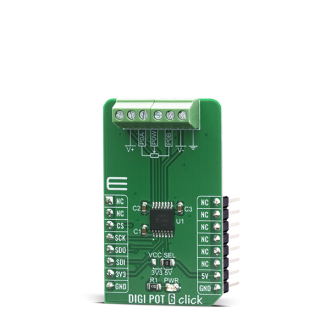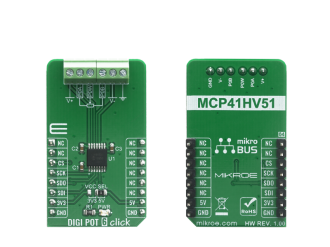
We strongly encourage users to use Package manager for sharing their code on Libstock website, because it boosts your efficiency and leaves the end user with no room for error. [more info]

Rating:
Author: MIKROE
Last Updated: 2020-05-28
Package Version: 1.0.0.0
mikroSDK Library: 1.0.0.0
Category: Digital potentiometer
Downloaded: 3359 times
Not followed.
License: MIT license
DIGI POT 6 Click features the MCP41HVX1 family of devices which have dual power rails (analog and digital). The analog power rail allows high voltage on the resistor network terminal pins. The analog voltage range is determined by the V+ and V- voltages.
Do you want to subscribe in order to receive notifications regarding "DIGI POT 6 click" changes.
Do you want to unsubscribe in order to stop receiving notifications regarding "DIGI POT 6 click" changes.
Do you want to report abuse regarding "DIGI POT 6 click".


Library Description
The library covers necessary functions that enable the usage of the DIGI POT 6 click board. User can read and write data to and from Volatile Wiper 0 and Volatile TCON Register or issue increment and decrement commands to Volatile Wiper 0. User can also Connect/Disconnect Resistor 0 Terminal A, Resistor 0 Terminal B, Resistor 0 Wiper and Resistor 0 Hardware Configuration Control.
Key functions:
void digipot6_write_data ( uint8_t reg_adr, uint8_t wr_byte ) - Function is used to write single byte of data into user defined register.uint8_t digipot6_read_data ( uint8_t reg_adr ); - Function is used to read single byte of data from user defined register.void digipot6_set_r0hw ( uint8_t state ); - Function is used to force Resistor 0 into the “shutdown” configuration.Examples description
The application is composed of three sections :
void application_task ( )
{
digipot6_write_data( DIGIPOT6_VOLATILE_WIPER_0, 0x00 );
for ( cnt = 0; cnt <= 255; cnt += 15 )
{
digipot6_write_data( DIGIPOT6_VOLATILE_WIPER_0, cnt );
Delay_ms( 10 );
wiper_val = digipot6_read_data( DIGIPOT6_VOLATILE_WIPER_0 );
ByteToStr( wiper_val, log_txt );
mikrobus_logWrite( " Wiper step : ", _LOG_TEXT );
Ltrim( log_txt );
mikrobus_logWrite( log_txt, _LOG_LINE );
Delay_ms( 1000 );
}
mikrobus_logWrite( "------------------------", _LOG_LINE );
Delay_ms( 1000 );
}
Other mikroE Libraries used in the example:
Additional notes and informations
Depending on the development board you are using, you may need USB UART click, USB UART 2 click or RS232 click to connect to your PC, for development systems with no UART to USB interface available on the board. The terminal available in all MikroElektronika compilers, or any other terminal application of your choice, can be used to read the message.